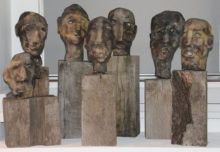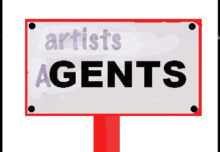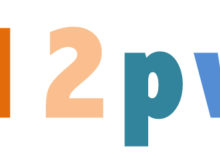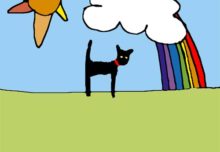The Genghis Khan Principle…
The ‘Genghis Khan Principle’ as it applies to self-employed one-man professional artists is the same as it is for any other small business. The main point is based on the well know rule of thumb which says that ‘turnover is vanity, profit is sanity, but cash is reality’.
This business mantra is so easy to ignore. But it is probably the difference between survival and failure. The special GKP focus is on one crucial factor namely ‘profit margins’. Profit margins are based on what is left after all your costs have been met.

Now artists are rather special small one-man businesses because our product is wonderfully inexpensive to produce. A painting on canvas might cost £10 or even less to make. Mark up to the asking price could be ten, twenty, fifty, or even more times that. Wow! So for instance that could be £10 to create an artwork making £500 when it sells. That is a huge profit. What is the problem?
Gross profit or net profit.
Gross profit is the difference between the making cost and selling price. The gross profit from £10 to £500 is great.
But this is where it goes wrong. The painting did not cost £10 to make.
The basic materials cost that, but the other costs pushed the actual cost up much further.
The investment in time that it took to learn how to make the artwork has not been included. The cost of space to make the artwork has been overlooked. Storage costs, wastage, office expenses, framing, brochures, webpages, marketing, heating, lighting etc etc, need I go on?
And even worse, the price of selling the artwork is going to push the total cost well over £10. Far too often artists actually give away half or even more of their turnover to an agent or gallery in sales commission.
The net profit is the profit after absolutely ALL costs have been included.
Turnover.
‘Turnover is vanity’ is the phrase that should be tattooed onto the artists forehead. Turnover is where so many artists mix up business with status. Selling more artwork and getting more turnover can blind the artist to the fact that they are not achieving a profit. An artist can be flattered by the ‘success’ of an exhibition if they sell lots of the exhibits. They made the goods, they presented the goods, they found willing art buyers who wanted the goods. The artist’s vanity button was pressed. But they are often selling at a loss.
Another pitfall is that increased turnover can push the business over thresholds that trigger off tax changes. Here in the UK at the moment there is a VAT [Value Added Tax] threshold of around £85,000 per annum. That means that if the business sells goods or services over that amount it has to register and charge an extra 20% tax on top of the selling price. VAT paid to achieve the threshold can be deducted. So it is tempting to spend more on marketing and sales to maximise extra turnover. However the extra cost of exhibitions, accountancy and book-keeping can be very hard to justify. Unless large increases in turnover are met it would often have been better to stick at turnover just below the threshold and concentrate on minimising costs.
Cash.
‘Cash is reality’ can also be such a misleading concept. Cash flow is often cited as a very important factor. And it is for most businesses. It doesn’t matter whether it is actual cash, or cheque, PayPal account, or credit card. It can be very tempting to agree a deal if and when the prospective buyer is willing to actually hand over the money on the spot. This is where so many artists are willing to take great chunks out of their profit margins to clinch the sale. The reality of cash in hand is not enough. It absolutely must be ‘profit’ as well as cash.
So many small business try to compete with much larger organisations by charging less. This is a big mistake. Big business can get higher profit margins because they have bigger buying budgets. They have economies of scale. Small businesses like artists should instead focus on creating high quality premium products and rare products. That is where they have the edge. So they can justify higher prices that reward them with better margins.
Profit.
‘Profit is sanity’. Yet profit is such a dirty word. Profit is what the GKP highlights as the most important factor. Not just some profit, but an absolute insistence on the vital import of the net profit margin. But profit is still seen as a bad motivator for artists. Surely, they say, artists make art for higher and more worthy reasons than profit. But the message behind the principle of GK is that these higher and more worthy reasons must be accompanied by profit. Instead, so often, the higher and more worthy reasons can scupper the artist by blinding him or her into bad business decisions.
It need not be so. There is nothing wrong about an artist being a business. It is not wrong for efficient business practices to be followed.
My message to artists is that they are prone to underestimate their actual costs. It is rather too easy to assume that anything over the material cost is profit. Many artists are tempted to get sales and the consequential feel-good factor by under pricing their artwork. They think that they have a huge profit margin. They even feel a bit guilty about making a profit. They try to achieve sales by discounting, or even more often, by seriously under pricing because they don’t realize what it really actually cost to make and sell the artwork.
*****************************************




